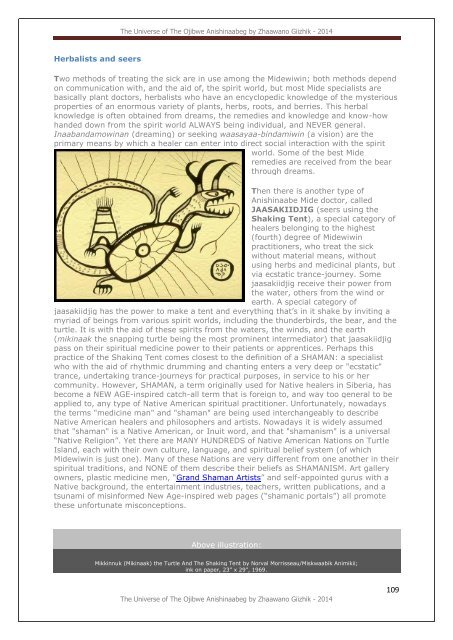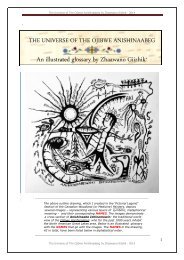The Universe Of The Ojibwe Anishinaabeg, an illustrated glossary by Zhaawano Giizhik*
A Glossary written and illustrated by Native Woodland artist Zhaawano Giizhik demonstrating a cross section of Anishinaabe Izhinamowin: the traditional worldview of the Ojibwe Anishinaabeg, who for the past 2 millennia inhabit the North American Great Lakes area.
A Glossary written and illustrated by Native Woodland artist Zhaawano Giizhik demonstrating a cross section of Anishinaabe Izhinamowin: the traditional worldview of the Ojibwe Anishinaabeg, who for the past 2 millennia inhabit the North American Great Lakes area.
You also want an ePaper? Increase the reach of your titles
YUMPU automatically turns print PDFs into web optimized ePapers that Google loves.
<strong>The</strong> <strong>Universe</strong> of <strong>The</strong> <strong>Ojibwe</strong> <strong>Anishinaabeg</strong> <strong>by</strong> Zhaaw<strong>an</strong>o Giizhik - 2014<br />
Herbalists <strong>an</strong>d seers<br />
Two methods of treating the sick are in use among the Midewiwin; both methods depend<br />
on communication with, <strong>an</strong>d the aid of, the spirit world, but most Mide specialists are<br />
basically pl<strong>an</strong>t doctors, herbalists who have <strong>an</strong> encyclopedic knowledge of the mysterious<br />
properties of <strong>an</strong> enormous variety of pl<strong>an</strong>ts, herbs, roots, <strong>an</strong>d berries. This herbal<br />
knowledge is often obtained from dreams, the remedies <strong>an</strong>d knowledge <strong>an</strong>d know-how<br />
h<strong>an</strong>ded down from the spirit world ALWAYS being individual, <strong>an</strong>d NEVER general.<br />
Inaab<strong>an</strong>damowin<strong>an</strong> (dreaming) or seeking waasayaa-bindamiwin (a vision) are the<br />
primary me<strong>an</strong>s <strong>by</strong> which a healer c<strong>an</strong> enter into direct social interaction with the spirit<br />
world. Some of the best Mide<br />
remedies are received from the bear<br />
through dreams.<br />
<strong>The</strong>n there is <strong>an</strong>other type of<br />
Anishinaabe Mide doctor, called<br />
JAASAKIIDJIG (seers using the<br />
Shaking Tent), a special category of<br />
healers belonging to the highest<br />
(fourth) degree of Midewiwin<br />
practitioners, who treat the sick<br />
without material me<strong>an</strong>s, without<br />
using herbs <strong>an</strong>d medicinal pl<strong>an</strong>ts, but<br />
via ecstatic tr<strong>an</strong>ce-journey. Some<br />
jaasakiidjig receive their power from<br />
the water, others from the wind or<br />
earth. A special category of<br />
jaasakiidjig has the power to make a tent <strong>an</strong>d everything that’s in it shake <strong>by</strong> inviting a<br />
myriad of beings from various spirit worlds, including the thunderbirds, the bear, <strong>an</strong>d the<br />
turtle. It is with the aid of these spirits from the waters, the winds, <strong>an</strong>d the earth<br />
(mikinaak the snapping turtle being the most prominent intermediator) that jaasakiidjig<br />
pass on their spiritual medicine power to their patients or apprentices. Perhaps this<br />
practice of the Shaking Tent comes closest to the definition of a SHAMAN: a specialist<br />
who with the aid of rhythmic drumming <strong>an</strong>d ch<strong>an</strong>ting enters a very deep or "ecstatic"<br />
tr<strong>an</strong>ce, undertaking tr<strong>an</strong>ce-journeys for practical purposes, in service to his or her<br />
community. However, SHAMAN, a term originally used for Native healers in Siberia, has<br />
become a NEW AGE-inspired catch-all term that is foreign to, <strong>an</strong>d way too general to be<br />
applied to, <strong>an</strong>y type of Native Americ<strong>an</strong> spiritual practitioner. Unfortunately, nowadays<br />
the terms "medicine m<strong>an</strong>" <strong>an</strong>d "sham<strong>an</strong>" are being used interch<strong>an</strong>geably to describe<br />
Native Americ<strong>an</strong> healers <strong>an</strong>d philosophers <strong>an</strong>d artists. Nowadays it is widely assumed<br />
that "sham<strong>an</strong>" is a Native Americ<strong>an</strong>, or Inuit word, <strong>an</strong>d that "sham<strong>an</strong>ism" is a universal<br />
“Native Religion”. Yet there are MANY HUNDREDS of Native Americ<strong>an</strong> Nations on Turtle<br />
Isl<strong>an</strong>d, each with their own culture, l<strong>an</strong>guage, <strong>an</strong>d spiritual belief system (of which<br />
Midewiwin is just one). M<strong>an</strong>y of these Nations are very different from one <strong>an</strong>other in their<br />
spiritual traditions, <strong>an</strong>d NONE of them describe their beliefs as SHAMANISM. Art gallery<br />
owners, plastic medicine men, “Gr<strong>an</strong>d Sham<strong>an</strong> Artists” <strong>an</strong>d self-appointed gurus with a<br />
Native background, the entertainment industries, teachers, written publications, <strong>an</strong>d a<br />
tsunami of misinformed New Age-inspired web pages (“sham<strong>an</strong>ic portals”) all promote<br />
these unfortunate misconceptions.<br />
Above illustration:<br />
Mikkinnuk (Mikinaak) the Turtle And <strong>The</strong> Shaking Tent <strong>by</strong> Norval Morrisseau/Miskwaabik Animikii;<br />
ink on paper, 23” x 29”, 1969.<br />
<strong>The</strong> <strong>Universe</strong> of <strong>The</strong> <strong>Ojibwe</strong> <strong>Anishinaabeg</strong> <strong>by</strong> Zhaaw<strong>an</strong>o Giizhik - 2014<br />
109





